The NVIDIA GeForce GTX 1650 Review, Feat. Zotac: Fighting Brute Force With Power Efficiency
by Ryan Smith & Nate Oh on May 3, 2019 10:15 AM ESTPower, Temperature, and Noise
As always, we'll take a look at power, temperature, and noise of the GTX 1650, though the 'mini' design shouldn't hold any surprises.
| GeForce Video Card Average Clockspeeds | |||||
| Game | GTX 1650 | ZOTAC GTX 1650 OC Gaming |
|||
| Boost Clock | 1665MHz | 1695MHz | |||
| Battlefield 1 | 1855MHz | 1880MHz | |||
| Far Cry 5 | 1847MHz | 1886MHz | |||
| Ashes: Escalation | 1826MHz | 1829MHz | |||
| Wolfenstein II | 1860MHz | 1905MHz | |||
| Final Fantasy XV | 1867MHz | 1837MHz | |||
| GTA V | 1886MHz | 1905MHz | |||
| Shadow of War | 1857MHz | 1863MHz | |||
| F1 2018 | 1855MHz | 1875MHz | |||
| Total War: Warhammer II | 1865MHz | 1902MHz | |||
| FurMark | 1629MHz | 1672MHz | |||
Power Consumption
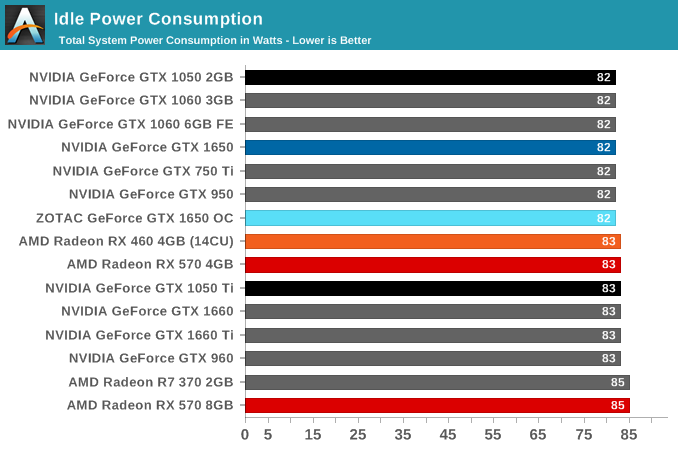
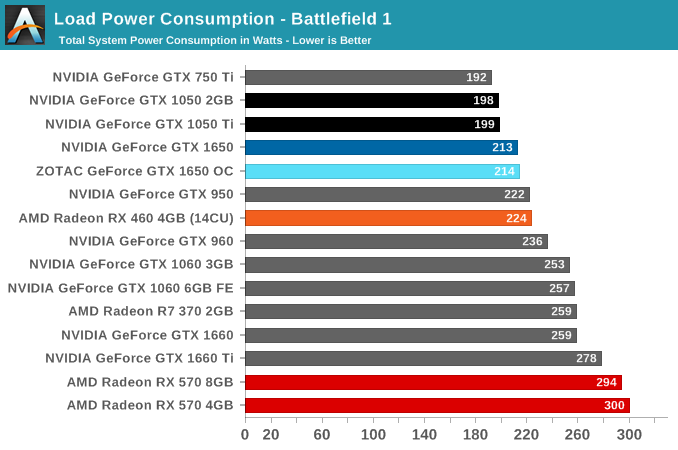

As for idle power consumption, the GTX 1650 falls in line with everything else, with total system power consumption reaching 83W. With contemporary desktop cards, idle power has reached the point where nothing short of low-level testing can expose what these cards are drawing.
Meanwhile at full load, the power consumption disparity between the RX 570 and GTX 1650 is one of the key factors in a direct comparison. Better – but not always – performance can be had for an additional ~75W at the wall, which maps well to the 150W TBP of the RX 570 over the 75W slot-power-only GTX 1650. Though the greater cooling requirements for a higher power card does means forgoing the small form factor.
Temperature
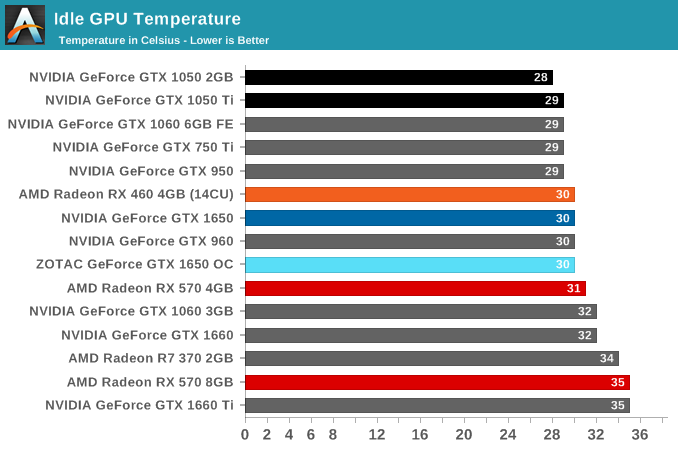
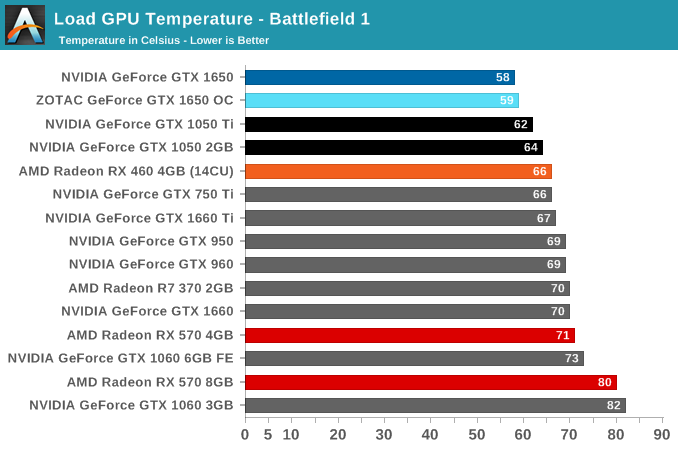
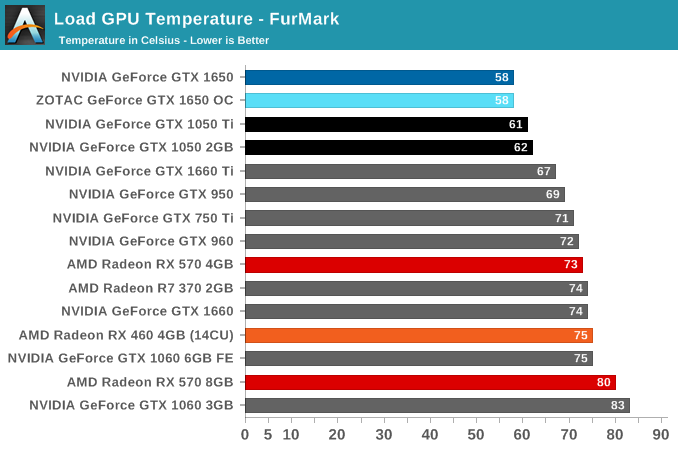
Temperatures all appear fairly normal, as the GTX 1650 stays very cool under load.
Noise
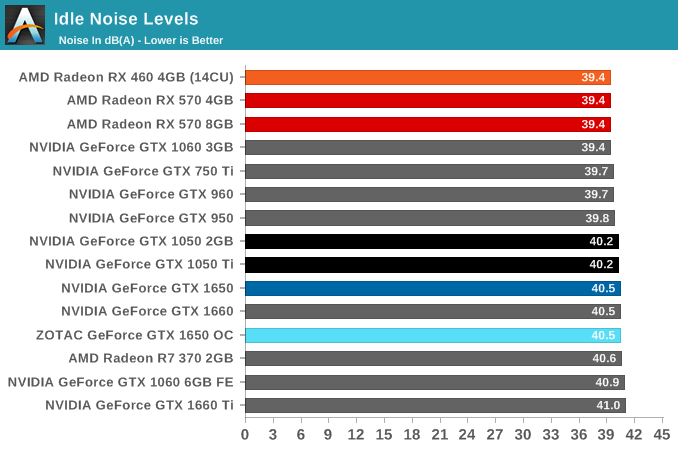
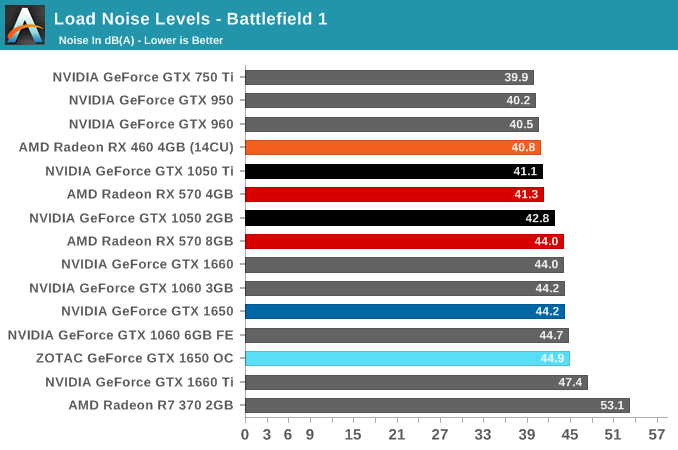
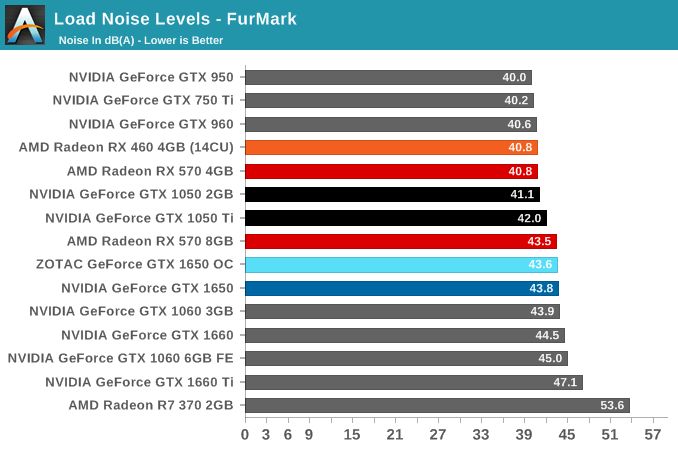
While the GTX 1650 may have good power and temperature characteristics, the noise is not as clean, if only because entry-level cards don't come with 0db fan idling technology, and SFF cards often have to deal with small shrill fans at relatively high RPM. The GTX 1650's fan isn't the worst, but it's not a standout best either. If anything, it looks to be the result of preferring cooling over acoustics, given the very low load temperatures.










126 Comments
View All Comments
dromoxen - Monday, May 20, 2019 - link
Its the current person mopping the floor who designed AMD's last generation of gfx cards.Another reason to buy this Crda is that you may not want the heat produced . I for one have started to use a 10w NUC in prefernece to a 75w HTPC just becuase the heating effect is less . UK,not jamaica or Saudi
plonk420 - Friday, May 3, 2019 - link
thanks for all the compute benches! yuuuugely appreciated!ads295 - Friday, May 3, 2019 - link
Can I use this to play ten year old games in full glory at 1440p?Ryan Smith - Friday, May 3, 2019 - link
Easily. Heck, depending on the game, you could probably get away with doing that on an iGPU.Ashinjuka - Saturday, May 4, 2019 - link
Probably not full-glory S.T.A.L.K.E.R. Definitely not full-glory S.T.A.L.K.E.R. with graphics mods.SaturnusDK - Friday, May 3, 2019 - link
Quite frankly at the $150, no one, and I do mean no one should buy this card. Even if you refurb an old OEM system the price difference up to an RX570 lets you buy a decent 80+ certified power supply and have a system that is more powerful and probably more power efficient at the same time. A standard OEM PSU in a an old computer is so inefficient that just replacing it makes up for more than the power consumption difference between a 1650 and an RX570. And gives you at least 15% more performance for the same amount of money spent.Oxford Guy - Saturday, May 4, 2019 - link
I doubt anyone should have purchased the 960 and yet it's the 5th most popular Steam card.This place didn't even bother to review it.
RSAUser - Friday, May 3, 2019 - link
A 1060 costs the same price as this 1650 here, I see no reason to buy it. Terrible value for money.RSAUser - Friday, May 3, 2019 - link
You can't compare the 1650 to the 950, they're priced completely differently at launch. Stop going directly with the product number. The 1650 is between 960 and 970.linuxgeex - Friday, May 3, 2019 - link
"Notably, B-frames incorporate information about both the frame before them and the frame after them, allowing for greater space savings versus simpler uni-directional P-frames."No. H.264 and H.265 (AVC/HEVC) have (optional) bi-directional P-Frames. That increases the complexity of the search required to create a B-Frame which would use significantly less data than a P-Frame. A lower-capability GPU may not be able to perform that search in real time, and in that case there's no point implementing it, even if it would increase compression efficiency, because the selling point of hardware HEVC compression is that it can be done in real time.
B-Frames are simpler than P-Frames. Not the other way around.
To be clear: I-Frames are effectively a still shot of the scene, like a JPEG.
P-Frames hold motion data with references to I-Frames and P-Frames - they encode linear motion for blocks in the image, they encode replacement blocks for new data needed to replace changes, ie when something moves over a background and reveals what was behind it.
If B-Frames are used, then intermediate frames are calculated between the P-Frames and their references based on their encoded block motion data. These result in what are called "tweens" in animation - images that are partway between a start and an end. The B-Frames encode small fixes for errors in the guessed (by linear interpolation) intermediate frames. The less motion there is, and the more linear the motion is, the more accurate the interpolated frames are and the more B-Frames you can have between P-Frames before the B-Frames become necessarily larger than a new P-Frame would have been. Generating those B-Frames and estimating / discarding them based on whether they can be as efficient as the P-Frames is a lot of work even when the P-Frames don't have bidirectional references. HEVC allows for more than just bidirectional (2 frame) motion prediction references. It allows using an P-Frame to inherit any other P-Frame's motion references and it allows P-Frames to target a B-Frame for motion estimation. That introduces an order of magnitude more search possibilities than H.264/AVC. HEVC with B-Frames disabled basically performs at a similar efficiency to AVC because all those options are off the table.